|
We've come a long way since the stealth bomber. Just
as smart gadgets have invaded our homes and revolutionized our lives
over the last 15 years, next-level weaponry has transformed the
military. The imperatives of the military have always been one of the
main drivers of technological development.
ARPANET, one of the internet's most important precursors was a Pentagon
project, while most of the technology in an iPhone originated with the
US Department of Defense.
Today, militaries all over the world are still pushing technological
boundaries. Since the turn of the millennium, weapons featuring a vast
range of technical sophistication have proven to be game changers.
Everything from concealed roadside bombs — cheap, primitive, and deadly
— to multibillion-dollar aerial lasers have transformed conventional
methods of combat and altered the world's technological and political
landscape.
Here are some of the most important weapons of the last 15 years.
|
|
Massive Ordnance Penetrator bombs
America's largest conventional bomb is precision-guided, 20 feet long,
weighs 30,000 pounds, and can blast through underground bunkers.
Boeing's Massive Ordnance Penetrator (MOP) bomb is designed to pierce 60
feet of reinforced concrete and then detonate 200 feet underground —
making no bunker safe.
After the MOP's first successful test in 2007, the US Air Force ordered
an arsenal of these mega-bombs. |
|
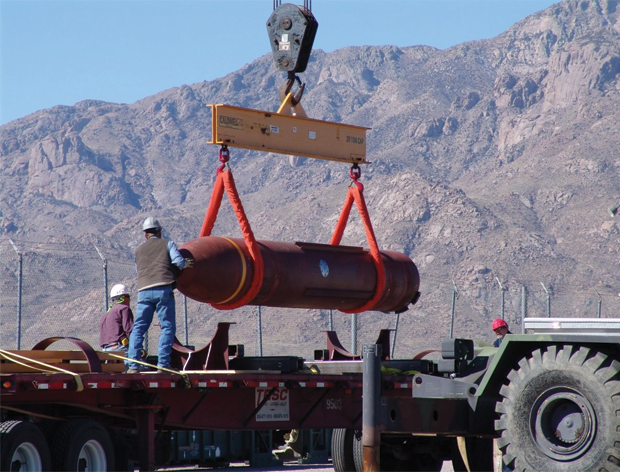 |
|
The Chinese anti-satellite program
In January of 2007, China initiated a new and terrifying era in warfare.
Using a C-19 ballistic missile, the People's Liberation Army destroyed
an out-of-commission weather satellite flying over 500 miles above the
surface of Earth.
In a single widely condemned move, China had militarized outer space. It
was a move that might have been inevitable, but whose long-term
consequences are startling. If satellites were considered legitimate
military targets, attacks could create debris fields that would knock
out entire orbits or create chain reactions that might destroy vital
communications and global-positioning satellites. Similarly, countries
could deploy weapons to outer space capable of destroying terrestrial
targets once the global taboo against space warfare is obliterated.
If that alarming worst-case scenario ever comes to pass, future
generations could identify the successful 2007 test as the moment that
space became a military frontier. The test also displayed China's
eagerness to develop weapons that its rivals would never use — showing
how a state can use asymmetrical means to close the gap with it more
powerful rivals. |
|
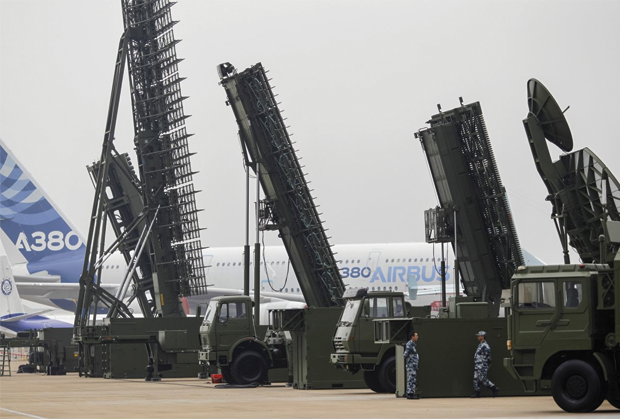
|
|
The X-47B
The Navy's X-47B is a strike-fighter-sized unmanned aircraft with the
potential to completely change aerial warfare.
Northrop Grumman's drone is capable of aerial refueling, 360-degree
rolls, and offensive weapon deployment. It's carried out the first
autonomous aerial refueling in aviation history, and has taken off and
landed from an aircraft carrier.
It cruises at half the speed of sound, and has a wingspan of 62 feet —
as well as a range of at least 2,400 miles, which is more than twice
that of the Reaper drone. |
|
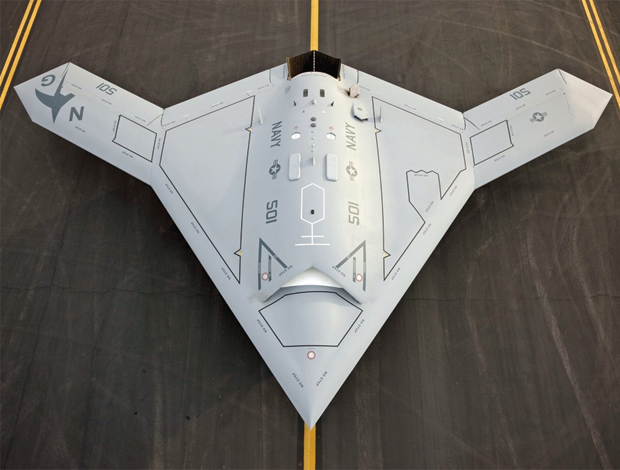
|
|
Reaper drones
The M19 Reaper drone has radically changed the way that the US carries
out military operations. First released in 2001, the Reaper drone has
been used in surveillance operations and strikes against militants in
places ranging from Iraq to Somalia to Pakistan.
Reaper drones are built to be effective at both surveillance and air
support. The drones are capable of reading a license plate from over two
miles away while at an altitude of 52,000 feet.
The drones can also carry 500-pound bombs and both air-to-ground
missiles and air-to-air missiles. Capable of staying airborne for 36
hours, the drone has given the US a remarkable ability to strike targets
quickly and quietly around the world — and without risking personnel in
the process. |
|
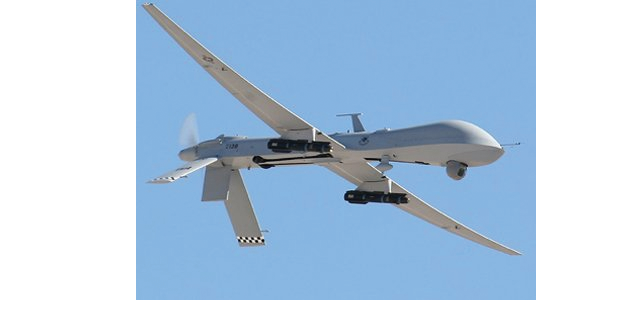 |
|
The V-22 Osprey
The V-22 Osprey is a multitask tilt rotor aircraft that has become a
staple of the Marine Corps since its introduction into service. The
Osprey can take off and land vertically like a helicopter, but it can
also travel at speeds approaching that of a fixed-wing plane.
The Osprey originally suffered from several worrisome accidents,
including a series of fatal crashes, before it was officially introduced
into service in 2007. The plane's later models have now become
absolutely indispensable for the Marines. It has seen use in combat and
rescue operations as far afield as Iraq, Afghanistan, and Libya.
The Air Force, Navy, and Marines have used the Osprey for almost every
conceivable mission. It has been used for troop transport, MEDEVAC
missions, supply transport, and aerial delivery; it is also being tested
for use as an aerial refueling platform. As it can land vertically, the
Osprey is also able to take part in operations normally out of bounds
for traditional aircraft, which typically need hundreds of feet of
runway space.
|
|
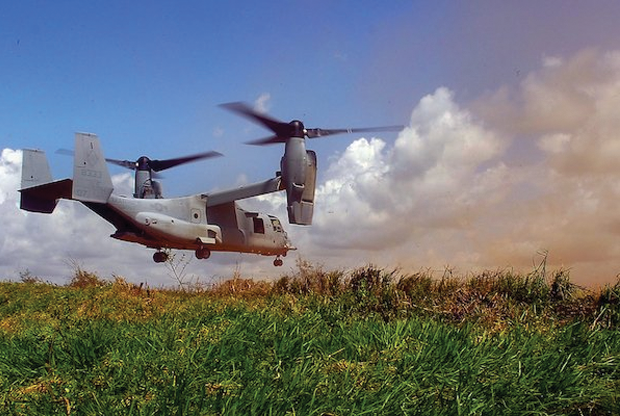 |
|
Seaborne Tomahawk Missiles
On January 27, the Navy carried out a successful test of a steerable
marine-launched Tomahawk missile. Guided by an F/A-18E/F Super Hornet,
the modified missile was able to change directions in flight and hit a
moving maritime target.
"This is potentially a game-changing capability for not a lot of cost,"
Deputy Secretary of Defense Bob Work said at the WEST 2015 conference.
"It's a 1,000-mile anti-ship cruise missile."
The new converted Tomahawks would have a range of almost 1,000 nautical
miles, allowing the US to maintain a considerable edge over rival naval
powers. On the other side of the Pacific, one of China's most
threatening new military advancements is its development of its own
advanced anti-ship cruise missiles. While potentially threatening to US
ships, these missiles would have just half the range of the converted
Tomahawk.
|
|
 |
|
THAAD missiles
The most advanced missile system on the planet can hunt and blast
incoming missiles right out of the sky with a 100% success rate — from a
truck, no less.
With its unmatched precision, the Terminal High-Altitude Area Defense (THAAD)
system can equalize conflicts around the world. With its mobility and
strategic battery-unit placement, the THAAD can close the gap between
mismatched military forces and take away an enemy's aerial advantage.
Impressively, the THAAD missile does not carry a warhead, instead using
pure kinetic energy to deliver "hit-to-kill" lethality to ballistic
missiles inside or outside of Earth's atmosphere. Each launcher carries
up to eight missiles and can send multiple kill vehicles, depending on
the severity of the threat.
|
|
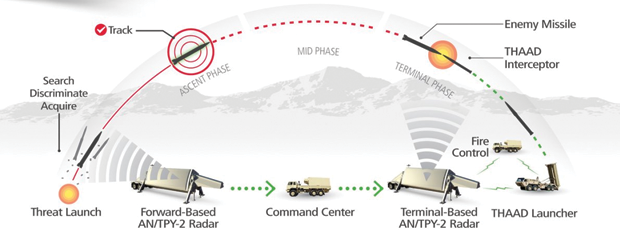 |
|
The YAL Airborne Laser Testbed
Weaponized lasers will likely be a feature on the battlefield of the
future. Even though only one of the weapons was ever built and the
program has been discontinued, the YAL Airborne Laser Testbed was an
important proof of concept.
The American weapon, which was first tested successfully in 2007, was
housed inside a converted 747 aircraft. The plane had the largest laser
turret ever built installed on its nose. The laser was built to
intercept tactical ballistic missiles midway through their flight path;
in a 2010 test, the YAL succeeded in shooting down a test target.
The military decided the YAL was impractical — in order to intercept a
missile, the aircraft would have to already be in the air, while the
weapon itself was expensive to fabricate, operate, and maintain. Still,
it demonstrated that enormous, high-powered lasers could destroy large
and fast-moving objects, and do so in midair.
If lasers ever become a feature of aerial combat, it will be because of
the precedent of the YAL. |
|
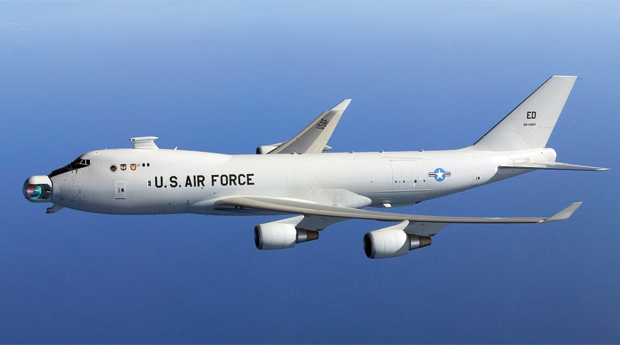 |
|
Heat rays
Both China and the US have developed nonlethal "heat rays" that cause
extreme pain and can aid in crowd control. The general idea behind the
weapons is to heat the water just below the surface of a person's skin
so as to induce pain, causing the target to flee without inflicting
death or incapacitation.
The Chinese heat ray can target individuals at up to 262 feet away. When
hooked up to an extra power source, the beam can hit targets at
distances of 0.6 miles.
The US version of the heat ray, known as the Active Denial System (ADS),
had a range of 1,000 meters and could raise the temperature of a
target's skin by 130 degrees. However, the ADS was recalled by the US
military without ever having been used over questions of its ethical
application.
|
|
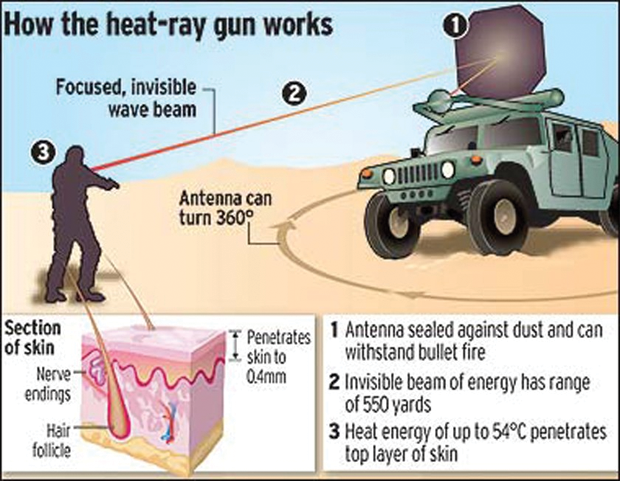 |